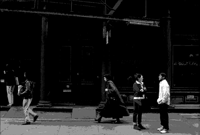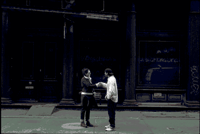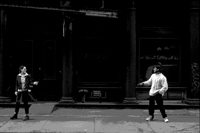|
|



Alle Fotos:
Igor und Svetlana Kopystiansky, The Day Before Tomorrow, 1999
VG Bild Kunst, Bonn 2005
|
english version

Die Ausstellung in der Kunsthalle Fridericianum, Kassel, die gemeinsam mit der Galerie des Fine Arts Center der Universität von Massachusetts, Amherst, konzipiert wurde, versammelt erstmals schwerpunktmäßig die Videoarbeiten und –installationen von Igor und Svetlana Kopystiansky. Neben früheren Arbeiten wie Incidents (1996-1997) oder The Day Before Tomorrow (1999) und der aktuellen Arbeit 526 wird auch die eigens für die Kunsthalle konzipierte neue Videoarbeit Yellow Sound zu sehen sein.
Das Interesse von Igor und Svetlana Kopystiansky gilt den scheinbar nebensächlichen Aspekten des Lebens, den Alltagssituationen, einfachen Gebrauchsgegenständen, achtlos weggeworfenen Abfällen – als Überbleibsel unserer Konsumgesellschaft. Auch das Nutzlose, Vergessene wird bei ihnen zu einem Teil unserer Welt, ein kulturelles Zeichen mit vielfältigen Bedeutungen und Assoziationen. Mit ihren Arbeiten geben sie dem scheinbar Wertlosen einen neuen, künstlerischen Wert. Damit stehen sie in einer künstlerischen Tradition von Duchamp und Tatlin, von den Dadaisten bis zu den Aktionskünstlern, die die Grenzen zwischen Kunstobjekt und Gebrauchsgegenstand aufhoben und neue Bewertungskategorien provozierten.
Während sich Svetlana Kopystiansky vor allem mit dem Medium Sprache in ihren frühen Performances und Installationen auseinander setzte, untersuchte Igor Kopystiansky mit seinen Objekten das Kunstsystem und die ihm zugrunde liegenden Strukturen. Als Künstlerpaar arbeiten sie seit den späten 1970er Jahren hauptsächlich für ihre Medieninstallationen zusammen. Und auch wenn diese Arbeiten ein gemeinschaftliches Produkt – von der Idee über die Ausführung bis zur Präsentation – darstellen, bewahren sie sich darin ihre Eigenständigkeit. Ein Beispiel dafür ist die 1999 entstandene Dia-Projektion The Day Before Tomorrow, die eine beliebige Straßensituation in New York City einfängt. Auch wenn es sich um eine und dieselbe Szene handelt, vermittelt sie zwei unterschiedliche Sichtweisen, die von Svetlana und die von Igor. Nebeneinander präsentiert werden die minimalen Abweichungen deutlich, wodurch sich am Ende eine innere Geschlossenheit ergibt. So ist auch ihr gesamtes Werk zu verstehen – ein Spiel zwischen Individualität und Komplementarität, eine Trennung, die nicht erst im Auge des Betrachters zu einem Ganzen verschmilzt.
Gruppenausstellungen (Auswahl): La Biennale de Venezia (Aperto) 1889; Sydney Biennial 1992; Sao Paulo Biennial 1994; Istanbul Biennial 1995; Skulpturen Projekte Münster 1997 (Svetlana Kopystiansky); Johannesburg Biennial 1997; Lyon Biennial 1997; First British Biennial 1999, Documenta11, 2002, Guggenheim Museum New York, 2005.
Einzelausstellungen (Auswahl): Martin-Gropius-Bau, DAAD / Berlinische Galerie, 1991; Kunsthalle Düsseldorf 1994; The Art Institute of Chicago (Svetlana Kopystiansky), 1996; Kunstmuseum Düsseldorf, 2000; Sprengel Museum Hannover, 2002; The Art Gallery of New South Wales, Sydney, 2003; Scottsdale Museum of Contemporary Art, Arizona, 2005.
21 December 2005 – 26 February 2006
The exhibition at the Kunsthalle Fridericianum, Kassel, organised in collaboration with the gallery of the Fine Arts Center at the University of Massachusetts, Amherst, focuses for the first time on video works and installations by Igor and Svetlana Kopystiansky. In addition to early works like Incidents (1996-1997) or The Day Before Tomorrow (1999) and the recent work 526, the new video work Yellow Sound produced especially for the Kunsthalle will be on view.
Igor and Svetlana Kopystiansky are interested in the seemingly trivial aspects of life, in everyday situations, simple articles of daily use, unthinkingly discarded refuse – the leavings of our consumer society. They also make useless, forgotten things part of our world, cultural signs with abundant meanings and associations. Their works lend the seemingly valueless a new, artistic value. This places them in the artistic tradition of Duchamp and Tatlin, the Dadaists and the action artists, who abolished the boundaries between works of art and articles of consumption and engendered new evaluation categories.
Whereas in her early performances, Svetlana Kopystiansky was concerned mainly with the medium of language, Igor Kopystiansky’s objects explore the art system and its underlying structures. The artist couple have been working together since the late 1970s chiefly on media installations. And although these works constitute joint products – from the idea to execution and presentation – the two artists retain their independence. One example is the 1999 slide projection The Day Before Tomorrow, which captures a random street situation in New York City. And even though the scene is one and the same, we are presented with two different ways of looking at it, that of Svetlana and that of Igor. Presented side by side, the minimal deviations become apparent which finally produce an inner unity. This is how their entire oeuvre is to be understood – a play between individuality and complementarity, a division that merges into a whole not only in the eye of the beholder.
Selected group exhibitions: La Biennale de Venezia (Aperto), 1889; Sydney Biennial, 1992; Sao Paulo Biennial, 1994; Istanbul Biennial, 1995; Skulpture. Projects in Münster, 1997 (Svetlana Kopystiansky); Johannesburg Biennial, 1997; Lyon Biennial, 1997; First British Biennial, 1999, Documenta11, 2002, Guggenheim Museum New York, 2005.
Selected solo exhibitions: Martin-Gropius-Bau, DAAD / Berlinische Galerie, 1991; Kunsthalle Düsseldorf 1994; The Art Institute of Chicago (Svetlana Kopystiansky), 1996; Kunstmuseum Düsseldorf, 2000; Sprengel Museum Hannover, 2002; The Art Gallery of New South Wales, Sydney, 2003; Scottsdale Museum of Contemporary Art, Arizona, 2005
|